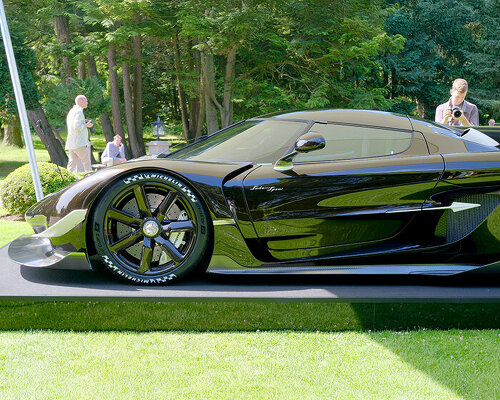a Scandinavian Homage to Speed
In late June, the doors of Koenigsegg’s Ängelholm factory opened to a small group of Aurora Scandinavian Concours drivers to preview the new Sadair’s Spear ahead of its public unveiling. designboom joined the group inside the former air force hangar, once home to the ‘Ghost Squadron’ Johan Röd, to observe the unveiling of a machine that represents a new threshold for the Swedish megacar company.
The preview took place during a private factory tour in time for the Concours. Here, founder Christian von Koenigsegg described Sadair’s Spear as the final tribute to his father, Jesko von Koenigsegg, whose passion for horse racing inspired the car’s name. In 1976, Jesko rode a horse called Sadair’s Spear in what would be his last race.
The following day, at the Aurora’s June 27th opening, the car was presented publicly for the first time — parked at the head of the Concours, the megacar was surrounded by a crowd of enthusiasts and collectors. Along with it being its first public appearance, it was an especially rare sight as only thirty examples of the Sadair’s Spear will ever be produced.
the Sadair’s Spear private preview at the Koenigsegg factory | image © designboom
A Presence Defined by Purpose
The Koenigsegg Sadair’s Spear is at once theatrical and purposeful. The proportions are familiar to anyone who has seen its predecessor, the Jesko — the same compact, sharply contoured nose and cab-forward canopy. Expert eyes will notice, however, that each surface is reconsidered. The front canards, or aerodynamic winglets, stand taller and more assertive. They are integrated into a reshaped bumper that increases airflow and cooling. Along the flanks, the wheel arch louvres appear almost delicate, but their function of guiding air to reduce pressure buildup is essential to the car’s stability at track speeds.
The rear is dominated by a new, double-blade wing mounted high on slender carbon pylons. Koenigsegg’s engineers explain that this active element is shaped to deliver greater downforce at lower speeds, making it more usable on typical circuits rather than only at extreme velocity. The combined effect of these aerodynamic adjustments is an increase in downforce of about twenty percent over the Jesko.
the megacar makes its public debut at the Aurora Scandinavian Concours | image © designboom
An Interior Stripped to the Essentials
Inside, the design language of the Koenigsegg Sadair’s Spear is one of subtraction. The central shift mechanism is gone, replaced by a sculpted key holder. Gear selection happens exclusively through paddles mounted on the steering wheel. The seats — rigid shells upholstered in minimal Alcantara — invite no illusions about the car’s purpose. Even the carbon fiber surfaces feel almost raw, their weave just visible beneath a thin satin coating. The atmosphere is informed by the principle of ‘adding less.’
As on all Koenigsegg models, a brushed metal ghost insignia can be found on the car. It’s explained that this logo is not just a branding flourish. It’s a reference to the history of the factory’s past life, the home of a Swedish air force squadron. Airplanes trained at night, and the group was aptly nicknamed the Ghost Squadron. The squadron used a ghost emblem on its aircraft, and Koenigsegg adopted this symbol as a tribute when it arrived at the former base.
Sadair’s Spear is displayed at the forefront of the Concours | image © designboom
Although Sadair’s Spear uses the same 5.0-liter twin-turbo V8 found in other Jesko models, its breathing and cooling systems have been revised. Larger hood vents, additional rear scoops, and an upgraded heat exchanger help sustain performance during repeated high-speed laps. When running on E85 fuel, the engine produces 1,625 horsepower, which is an astonishing figure even in a segment defined by excess.
The Light Speed Transmission, with its nine forward gears and rapid-shifting multi-disc clutches, remains one of Koenigsegg’s defining technologies. In Sadair’s Spear, its operation feels simpler still, with the removal of the central shifter emphasizing the immediacy of paddle inputs. The system is engineered so that shifts between any two gears happen almost instantaneously, a feature the test drivers demonstrated later in the day on the runway behind the factory.
Christian von Koenigsegg names the car after his father’s final racehorse from 1976 | image © designboom
the design refines the Jesko’s silhouette with taller canards and a new rear wing | image © designboom
engineers increase downforce by around twenty percent over the Jesko Attack | image © designboom
the cockpit removes the central shifter and focuses on minimal driver controls | image © designboom
the car made its public debut at the Aurora Scandinavian Concours | image © designboom
project info:
model: Sadair’s Spear
manufacturer: Koenigsegg | @koenigsegg
event: Aurora Scandinavian Concours | @theauroraconcours
premiere: June 2025
The post the sculpted design of koenigsegg sadair’s spear premiered at aurora concours in sweden appeared first on designboom | architecture & design magazine.

